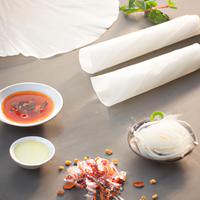
1 serving (28 grams) contains 100 calories, 1.5 grams of protein, 0.2 grams of fat, and 23.0 grams of carbohydrates.

Log this food in SnapCalorie

Nutrition Information
Calories |
847.5 | ||
|---|---|---|---|
% Daily Value* |
|||
| Total Fat | 1.7 g | 2% | |
| Saturated Fat | 0 g | 0% | |
| Polyunsaturated Fat | 0 g | ||
| Cholesterol | 0 mg | 0% | |
| Sodium | 84.7 mg | 3% | |
| Total Carbohydrates | 194.9 g | 70% | |
| Dietary Fiber | 4.2 g | 15% | |
| Sugars | 0 g | ||
| protein | 12.7 g | 25% | |
| Vitamin D | 0 mcg | 0% | |
| Calcium | 42.4 mg | 3% | |
| Iron | 1.7 mg | 9% | |
| Potassium | 42.4 mg | 0% | |
* Percent Daily Values are based on a 2,000 calorie diet. Your daily values may be higher or lower depending on your calorie needs.
Food Attributes
Source of Calories
About Rice paper sheets
Rice paper sheets are thin, translucent wrappers made primarily from rice flour and water, often mixed with tapioca starch for added pliability. Originating in Vietnam and heavily used in Southeast Asian cuisine, they’re a staple for creating fresh spring rolls and other dishes. These sheets are naturally gluten-free and low in calories, offering a lighter alternative to wheat-based wrappers. They’re typically consumed raw or briefly rehydrated, preserving their minimal nutrient profile. Though rice paper itself is low in fiber and protein, it serves as a versatile base for nutrient-packed fillings such as fresh vegetables, herbs, lean proteins, and healthy fats. It contains minimal fat and sodium, making it a heart-friendly choice when paired with wholesome ingredients. However, watch for high-sodium dipping sauces, which can offset its health benefits. Rice paper sheets are ideal for those seeking a flexible, gluten-free wrapper that complements balanced, colorful meals.



